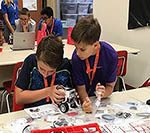 The purpose of this column is to discuss STEM careers; specifically, the academic path required to obtain a STEM career and motivating our youth to pursue these lucrative and wildly in-demand careers. But for this month’s column, I’d like to take the opportunity to highlight some big news that has significant impact on STEM in the Central Florida area, and that is the announcement of the retirement of UCF’s President John Hitt. The growth UCF has experienced and its impact to STEM industries in Central Florida is no coincidence. In this case, correlation is causation. In President Hitt’s 25 years as UCF’s commander-in-chief, Central Florida has transformed from an afterthought, where employees of the tourism industry reside, to a vibrant technology hub. What follows are a few examples of these industries.
The purpose of this column is to discuss STEM careers; specifically, the academic path required to obtain a STEM career and motivating our youth to pursue these lucrative and wildly in-demand careers. But for this month’s column, I’d like to take the opportunity to highlight some big news that has significant impact on STEM in the Central Florida area, and that is the announcement of the retirement of UCF’s President John Hitt. The growth UCF has experienced and its impact to STEM industries in Central Florida is no coincidence. In this case, correlation is causation. In President Hitt’s 25 years as UCF’s commander-in-chief, Central Florida has transformed from an afterthought, where employees of the tourism industry reside, to a vibrant technology hub. What follows are a few examples of these industries.
There’s no question about the importance of the aerospace industry in Central Florida, specifically the close ties with NASA, Kennedy Space Center and the surrounding support industry. In addition to the space industry that I discussed in a prior column, the modeling and simulation industry in Central Florida also has thrived under President Hitt’s watch. The amount of investment the university has made in Research Parkway and close collaborations with the defense industry, specifically the Army’s Program Executive Office for Simulation, Training, and Instrumentation (PEO STRI) and the Naval Air Warfare Center Training Systems Division (NAWCTSD), are the foundation for the vibrant simulation and training industry. UCF’s graduate program in Modeling and Simulation is one of the few – and by far the best – programs in the country. This is a great example of how the synergies between local industries and academia can intertwine to support the local industries working well.
The video game industry also is a close cousin of the modeling and simulation industry. EA Sports has a significant presence in the area with offices in Maitland. The golf simulation industry in the region also is second to none, and many of the skill sets needed in the modeling and simulation industry as well as the video game development industry have a lot in common. This is in addition to the needs of the tourism and hospitality industry’s needs for game designers. UCF’s Florida Interactive Entertainment Academy is consistently ranked among the top graduate game design programs in the country. This is another good example of the synergies and direct ties between academia and industry.
Two other similar examples of strategic partnerships between UCF and burgeoning industries are the advanced sensor manufacturing effort known as BRIDG and the booming medical industry here in Lake Nona. These two initiatives might be younger in age than the aerospace industry and modeling, simulation, and game design industries in Central Florida, but in due time there is no question they will have a similar impact on the region as the established industries. President Hitt deserves significant kudos for putting UCF’s muscle behind these efforts. The region will have significant demand for skilled STEM workers to feed the growth of these up-and-coming industries in Central Florida.
So what kind of career paths should one take to ride the growth wave of these industries? For the medical industry, there are a number of STEM paths to keep in mind beyond your traditional health care practitioner careers. Hardware and software expertise will continue to grow. Automation and machine learning will continue to have an increased impact on the healthcare industry. For example, IBM’s Watson and other similar technology will be used to predict and hopefully prevent illnesses. Intuitive Surgical’s DaVinci machine and other autonomous and remotely-operated machinery will only continue to rise in importance. Regarding the advanced sensor manufacturing BRIDG initiative, this topic is so new that it is more difficult to understand the potential opportunities that this will bring to the region. Over the next few years, I predict the related industries that grow around the BRIDG initiative will be just as important as the manufacturing facility itself. This includes consumer electronics, wearable technology, raw material suppliers, and other similar technology companies that will benefit from being collocated with the manufacturing facility.
A great deal of gratitude is owed to UCF President John Hitt for his vision and strategy in investing in the STEM initiatives mentioned above. The Central Florida region is more than just tourism and aerospace. Other thriving industries exist and will continue to grow, including modeling and simulation, game design, health care, advanced sensor manufacturing, and many, many more. Dr. Hitt saw the potential in these industries and chose to position UCF to be able to capitalize on these industries and to be at the forefront of feeding graduates from UCF to these industries. The concept of being the leading partnership university was the brainchild of President Hitt, and, for that, the Central Florida region thanks him.


